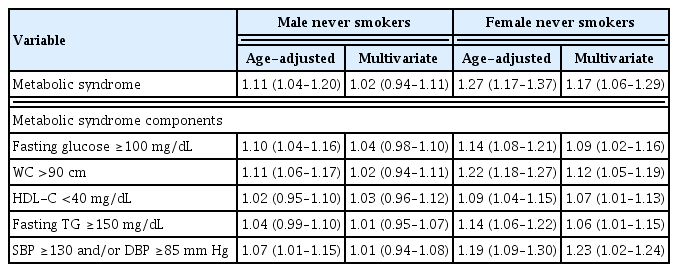Search
- Page Path
- HOME > Search
Original Article
- Clinical Study
- Association between Secondhand Smoke Exposure and Metabolic Syndrome in 118,609 Korean Never Smokers Verified by Self-Reported Questionnaire and Urine Cotinine
- Ji Hye Kim, Byung Jin Kim, Young Youl Hyun, Jin Ho Kang
- Endocrinol Metab. 2020;35(4):892-900. Published online December 23, 2020
- DOI: https://doi.org/10.3803/EnM.2020.847

- 4,288 View
- 100 Download
- 4 Web of Science
- 4 Crossref
-
 Abstract
Abstract
 PDF
PDF Supplementary Material
Supplementary Material PubReader
PubReader  ePub
ePub - Background
No study has reported the association between secondhand smoke (SHS) exposure and metabolic syndrome (MetS) in self-reported never smokers verified by both self-reported questionnaire and urine cotinine.
Methods
A total of 118,609 self-reported and cotinine-verified never smokers (38,385 male; age 34.8±7.1 years) who participated in the Kangbuk Samsung Health Study between 2011 and 2016 were included. Cotinine-verified never smokers were defined as individuals with urinary cotinine <50 ng/mL. SHS exposure was defined as current exposure to passive smoking indoors at home or workplace.
Results
Prevalence of SHS exposure in the overall population was 22.6% (27.4% for males and 20.3% for females (P<0.001). The overall prevalence of MetS was 6.8% and was higher in males than in females (10.7% vs. 4.9%, P<0.001). In both genders, MetS prevalence was higher in the SHS exposure group than the non-SHS exposure group (11.3% vs. 10.4%, P=0.010 for males; 5.8% vs. 4.6%, P<0.001 for females). However, there was significant gender interaction for the association between SHS exposure and MetS (P for interaction=0.010). In the multivariate regression analyses, SHS exposure was associated with increased MetS odds only in females (odds ratio [95% confidence interval], 1.02 [0.94 to 1.11] in male vs. 1.17 [1.06 to 1.29] in female). In particular, females with SHS exposure of ≥1 hour/day and ≥3 times showed increased odds of MetS compared with those without SHS exposure (1.22 [1.02 to 1.45], 1.30 [1.14 to 1.49]).
Conclusion
This cross-sectional study showed that SHS exposure was significantly associated with prevalence of MetS in self-reported and cotinine-verified female never smokers. -
Citations
Citations to this article as recorded by- Combined Influence of Eight Lifestyle Factors on Metabolic Syndrome Incidence: A Prospective Cohort Study from the MECH-HK Study
Yun-Yang Deng, Fei-Wan Ngai, Jing Qin, Lin Yang, Ka-Po Wong, Harry-Haoxiang Wang, Yao-Jie Xie
Nutrients.2024; 16(4): 547. CrossRef - Association of Zinc Intake, Tobacco Smoke Exposure, With Metabolic Syndrome: Evidence from NHANES 2007–2018
Shengxiang Yang, Qian Chen, Lin Wang
Biological Trace Element Research.2024;[Epub] CrossRef - The association between urinary cotinine level and metabolic syndrome profiles among adolescents: findings from the Ewha Birth and growth study
Hyunjin Park, Ui-Jeong Kim, Eun Jeong Choi, Seunghee Jun, Bomi Park, Hye Ah Lee, Hae Soon Kim, Hyesook Park
BMC Public Health.2023;[Epub] CrossRef - Association of environmental tobacco smoke exposure with metabolic syndrome: A longitudinal Cohort Study of 71,055 never smokers
Hyo-In Choi, Seung Jae Lee, Jeong Gyu Kang, Sung Ho Lee, Bum Soo Kim, Byung Jin Kim
Nutrition, Metabolism and Cardiovascular Diseases.2022; 32(11): 2534. CrossRef
- Combined Influence of Eight Lifestyle Factors on Metabolic Syndrome Incidence: A Prospective Cohort Study from the MECH-HK Study

Case Report
- A Case of Insulinoma Localized by Percutaneous Tracshepatic Portal Catheterization with Insulin Hormone Assay.
- Byung Jin Kim, Jun Sang Lee, Kyung Seuk Lee, Byung Gyu Park, In Joo Kim, Yong Ki Kim
- J Korean Endocr Soc. 1996;11(3):355-361. Published online November 7, 2019
- 1,030 View
- 21 Download
-
 Abstract
Abstract
 PDF
PDF - The diagnosis of insulinoma is made primarily by the detection of an inappropriately elevated serum insulin level in the presence of a low blood glucose level. The successful resection of insulin-secreting islet cell turnors is greatly facilitated by accurate preoperative localization. But, the modalities of ultrasonography, computer tomography, magnetic resonance imaging and selective arteriography often fail to detect insulinoma smaller than 1.5 cm in diameter. In this report, we describe a patient with an insulinoma successfully localized by percutaneous transhepatic portal vein sampling but not by abdominal ultrasonography, computer tomography and selective arteriography. Percutaneous transhepatic portal vein catheterization with insulin sampling showed sudden step-up of insulin concentrations near 6 cm from distal splenic vein. During operation, a 1×1.3cm sized tumor was found at the junction of body and tail of pancreas, so distal pancreatectomy was performed, We propose that preoperative percutaneous transhepatic portal vein catheterization with measurement of radioimmunoactive insulin concentration is a safe and reliable method and plays an important role to localize insulinoma that are considered occult after conventional diagnostic studies have been negative.


 KES
KES

 First
First Prev
Prev



